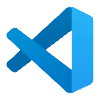How to Connect Blink Shell to a Fresh VS Code Server Install
How to Connect Blink Shell to a Fresh VS Code Server Install
From IDE apps to plain old text editors, there are many ways to code on your iPad. As convenient as these options may be, however, few deliver the power you'd expect from a desktop experience. Upgrading to Blink and VS Code Server is the easiest way to boost your productivity and enjoy the best of both worlds.
Want to spend less time setting up and more time coding? Here's how to get moving with VS Code Server and Blink Build or your favorite cloud instance.
What Is VS Code Server?
Visual Studio Code Server is a code server that runs on your machine of choice. After installing, you'll be able to connect a local VS Code instance (like the desktop app or browser version) to the host running the server — so that you can develop remotely.
VS Code Server's close integration with the wider ecosystem makes it nice and easy to use. It also lets you get work done on platforms that don't support the VS Code desktop version — like your tablet or phone. To sum up, you can use features like navigation, debugging, and completions no matter where your code actually lives.
VS Code Server Deployment Options
There are two main ways to deploy a VS Code Server: self-hosting or using a cloud instance.
With cloud-hosted solutions, like GitPod or Codespaces, you gain the advantage of self-managed convenience. If you'd rather not mess with configurations or build settings, spinning up a container or cloud VM might be the easiest option.
Self-hosting, on the other hand, gives you total control over what you install and how you work — without asking you to share repo access or sensitive data with third parties. You can work with multiple projects or repos, and you're not stuck with a vendor-supplied version of VS Code.
Which should you choose? With the right hosting-agnostic tools, you can develop seamlessly either way. For instance, no matter whether you're working in the cloud or locally, Blink Build makes it easy to roll your own custom dev runtime on demand.
When it comes to picking a VS Code Server brand, it's a matter of preference. Most people use the Microsoft option or the GitPod alternative.
How to Install VS Code Server From Microsoft
Microsoft's VS Code Server is open-source. It also supports the complete extensions marketplace.
...But nothing is perfect. For example, VS Code Server's licensing is somewhat restrictive. Another issue is that Microsoft is known for pushing its own services, like Github Copilot, and collecting telemetry by default.
Create a Binary Directory
Blink Build makes it easy to work at your own pace by preserving the content of your home folder between runs. This means we can create a binary directory to avoid having to reinstall VS Code Studio each session:
Next, we'll need to make the contents of this directory available system-wide. To do this, we'll add our new directory to the PATH variable. Open the ~/.bashrc file in your favorite editor, and append the following line:
Lastly, we apply the changes we just made using the source command:
Install VS Code Server in the Binary Directory
Now, we'll download the VS Code Server tarball.
Next, we extract the tarball and move it to the binary directory we created earlier:
If we did this correctly, running which code should display the binary in our directory.
3 Run the Remote Code Server
Running is simple. We create an accessible tunnel with the aptly-named subcommand:
But here's where we deviate from the standard VS Code Server instructions. Instead of logging in via a browser, we'll use Blink. Copy the URL, and in a new Blink shell, run:
How to Install OpenVSCode Server From GitPod
This version is the OG — GitPod published it before Microsoft released its open-source implementation. It's open-source and includes a fully open license.
The downside? OpenVSCode Server isn't compatible with the official extensions marketplace. With that said, the Open VSX extension registry has a lot going for it.
Create a Binary Directory
Follow the same steps for the Microsoft VS Code Server installation above.
Install OpenVSCode Server
First, we'll download the latest release for our OS from the GitHub repository. Make sure to pick an option compatible with your architecture!
Then, we'll extract the tarball and cd into the resulting directory:
Running OpenVSCode Server
The OpenVSCode server binary is in the bin subdirectory. We'll run it without arguments (but you can list the available options by adding --help):
If all went well, you'll see a status message with a URL In a new Blink shell, run the code with that URL:
Go Forth and Code Remotely
That's it! You now have a VS Code server to play around with via Blink. Stay tuned for more pointers on creating a smoother dev experience, and let us know what you're building.
Like this project
Posted Jan 16, 2024
Blink Shell needed to teach users how to start coding with VS Code on mobile devices. I wrote (and stress-tested) this tutorial to simplify the process.
Likes
0
Views
81








